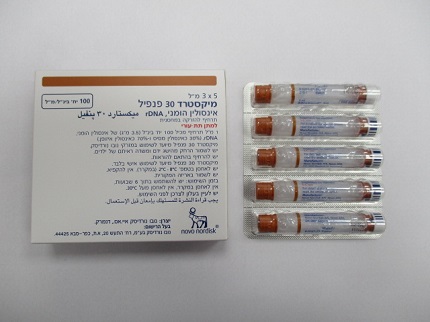Quest for the right Drug

מיקסטרד 30 פנפיל MIXTARD 30 PENFILL (INSULIN (HUMAN))
תרופה במרשם
תרופה בסל
נרקוטיקה
ציטוטוקסיקה
צורת מתן:
תת-עורי : S.C
צורת מינון:
תרחיף להזרקה : SUSPENSION FOR INJECTION
עלון לרופא
מינוניםPosology התוויות
Indications תופעות לוואי
Adverse reactions התוויות נגד
Contraindications אינטראקציות
Interactions מינון יתר
Overdose הריון/הנקה
Pregnancy & Lactation אוכלוסיות מיוחדות
Special populations תכונות פרמקולוגיות
Pharmacological properties מידע רוקחי
Pharmaceutical particulars אזהרת שימוש
Special Warning עלון לרופא
Physicians Leaflet
Pharmacological properties : תכונות פרמקולוגיות
Pharmacodynamic Properties
5.1 Pharmacodynamic properties Pharmacotherapeutic group: Drugs used in diabetes. Insulins and analogues for injection, intermediate- or long-acting combined with fast-acting, insulin (human). ATC code: A10AD01. Mechanism of action and pharmacodynamic effects The blood glucose lowering effect of insulin is due to the facilitated uptake of glucose following binding of insulin to receptors on muscle and fat cells and to the simultaneous inhibition of glucose output from the liver. Mixtard is a dual-acting insulin. Onset of action is within ½ hour, reaches a maximum effect within 2–8 hours and the entire duration of action is up to 24 hours.
Pharmacokinetic Properties
5.2 Pharmacokinetic properties Insulin in the blood stream has a half-life of a few minutes. Consequently, the time-action profile of an insulin preparation is determined solely by its absorption characteristics. This process is influenced by several factors (e.g. insulin dose, injection route and site, thickness of subcutaneous fat, type of diabetes). The pharmacokinetics of insulin medicinal products are therefore affected by significant intra- and inter-individual variation. Absorption The absorption profile is due to the product being a mixture of insulin products with fast and protracted absorption respectively. The maximum plasma concentration of the fast-acting insulin is reached within 1.5–2.5 hours after subcutaneous administration. Distribution No profound binding to plasma proteins, except circulating insulin antibodies (if present) has been observed. Metabolism Human insulin is reported to be degraded by insulin protease or insulin-degrading enzymes and possibly protein disulfide isomerase. A number of cleavage (hydrolysis) sites on the human insulin molecule have been proposed; none of the metabolites formed following the cleavage are active. Elimination The terminal half-life is determined by the rate of absorption from the subcutaneous tissue. The terminal half-life (t½) is therefore a measure of the absorption rather than of the elimination per se of insulin from plasma (insulin in the blood stream has a t½ of a few minutes). Trials have indicated a t½ of about 5–10 hours.

שימוש לפי פנקס קופ''ח כללית 1994
לא צוין
תאריך הכללה מקורי בסל
01/01/1995
הגבלות
תרופה שאושרה לשימוש כללי בקופ'ח
מידע נוסף
